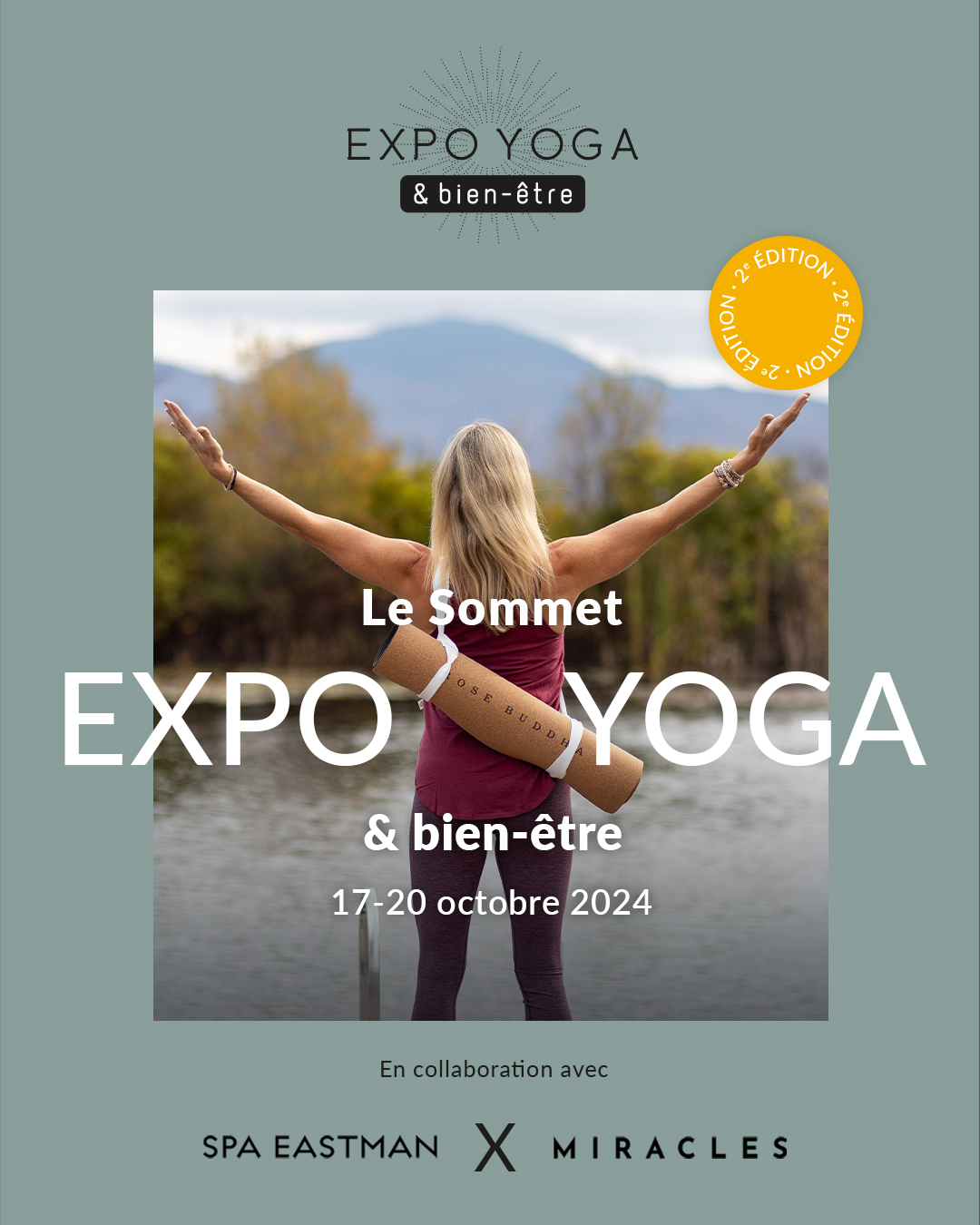Upright and Uplifted
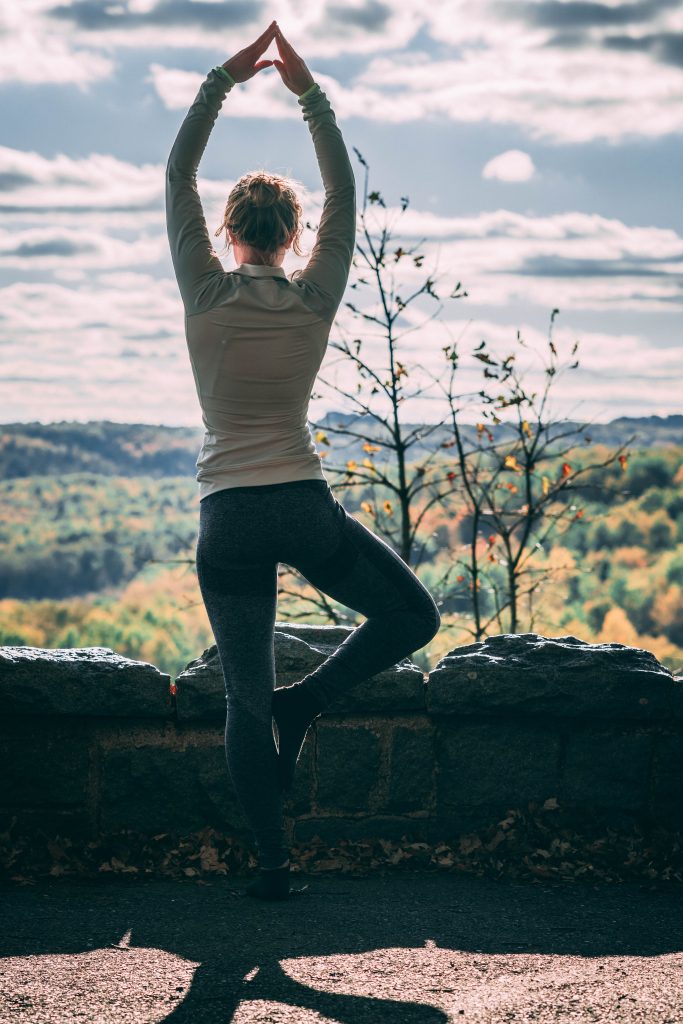
Six Yoga Poses to Practice Daily for Better Posture
Posture: The position or bearing of the body; a state or condition at a given time especially with respect to capability in particular circumstances; a conscious mental or outward behavioural attitude.
Even according to the strict dictionary definition of the word, posture refers to something more than simply standing up straight.
In yoga, of course, we know that our posture says much more about us than simply the health of our muscles and the alignment of our skeleton. The way we hold ourselves in space reflects the inner stance we bring to meet situations, interact with others, and navigate the world around us.
Just as our inner attitude can influence our posture, yoga teaches that the opposite is also true. We can affect our mind, our mood, and even our way of being with others by simply holding ourselves upright in a healthy, balanced way.
Like all asanas, “good” posture for yogis is not simply about holding ourselves straight and tall. It’s a stance where stability and strength partners with freedom and release; where we inhabit the perfect balance of steadiness and ease.
Here are six simple poses to practice regularly for a posture that allows you to meet the world with equipoise:
Hold each pose for 5-10 breaths.
1. Mountain Pose (Tadasana) with Clasped Hands Behind the Back
Benefits: Aligns the whole body, opens the chest, strengthens the upper back.
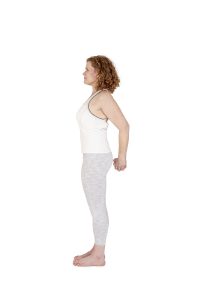
Instructions:
- Stand with your feet hip distance apart. Line up your heels behind your second and third toes. The weight should be even on each foot, from front to back and side to side.
- Lift your kneecaps, and engage your quadriceps muscles. Then, isometrically press the backs of your knees forward without actually bend them, to engage your quads and hamstring muscles equally.
- Take the tops of your thighs back and tip the top of your sacrum in, creating an inward curve in your low back. Draw your tailbone down toward your heels.
- Lengthen your torso up, roll the tops of your arms back, and interlace your fingers behind your back. Engage the shoulder blades onto the back of your ribcage. Lift and open your chest. Broaden your collarbones.
- Lift your rib cage evenly away from your pelvis; allow the back of your neck to lengthen upwards. Feel that your neck is free and your head is effortlessly balanced on the top of your spine.
2. Chair Pose (Utkatasana)
Benefits: Tones the leg muscles, ankles, calves, and back. Strengthens the hip flexors, external rotators of the outer hips and glutes. Stretches the chest and shoulders, stimulates the diaphragm and heart.

Instructions:
- From Mountain Pose, inhale and raise your arms perpendicular to the floor. Either keep your arms parallel, palms facing inward, or join your palms together.
- Exhale and bend your knees, as if you were sitting back onto a chair. Take your thighs as parallel to the floor as possible. Keep your thighs parallel to each other and descend the tops of the thighbones toward your heels.
- Firm your shoulder blades against the back. Roll your sitting bones under and scoop your tailbone in to lengthen your lower back.
- To come out of this pose, inhale and press down into your feet and straighten your knees. Exhale and release your arms to your sides into Tadasana.
3. Downward-Facing Dog Pose (Adho Mukha Svanasana)
Benefits: Stretches the shoulders, hamstrings, calves, arches, and hands, strengthens the wrists, arms and legs.
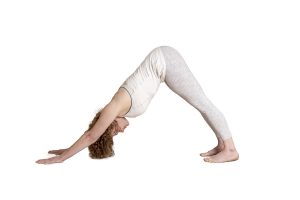
Instructions:
- Begin on the floor on your hands and knees. Set your knees directly below your hips and your hands slightly forward of your shoulders. Spread your palms, have your index fingers parallel or slightly turned out, and turn your toes under.
- Exhale and lift your knees away from the floor. At first keep the knees slightly bent and the heels lifted away from the floor. Lift your sitting bones up toward the ceiling, and from your inner ankles draw up the inner legs into the groins.
- Press the tops of your thighs back and stretch your heels down toward the floor. Straighten your knees.
- Press the bases of the index fingers down into the floor and firm the muscles of your arms. Draw from the heels of your hands up to your shoulders, especially lifting the upper inner arms. Firm your shoulder blades onto your back and stretch your chest away from your hands and toward your legs. Keep your ears in line with your arms.
4. Plank Pose (Phalakasana)
Benefits: Tones all of the core muscles of the body, including the deep stabilizing muscles of the abdomen, the chest, and low back. Strengthens the arms, wrists, shoulders, and spinal muscles.
Instructions: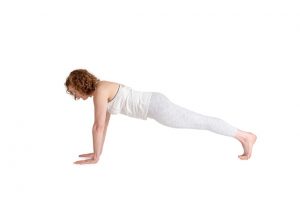
- From Downward-Facing Dog, inhale and draw your torso forward until the arms are perpendicular to the floor, the shoulders are directly over the wrists, and the torso is parallel to the floor.
- Press your outer arms inward and press the base of your index fingers into the floor. Firm your shoulder blades against your back, then broaden them away from the spine. Spread your collarbones away from the sternum.
- Lift your thighs up toward the ceiling. Draw your tailbone in and lengthen it toward your heels.
- Soften the spine between your shoulder blades while keeping the back of the waistline full. Lengthen the base of the skull away from the back of the neck and look straight down at the floor.
5. Locust Pose (Salabhasana)
Benefits: Strengthens all the spinal muscles.
Instructions: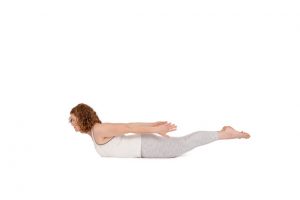
- Lie on your belly with your arms along the sides of your torso, palms up, forehead resting on the floor. Turn your big toes toward each other to inwardly rotate your thighs, and firm your buttocks so your tailbone presses toward your pubis.
- Inhale and lift your head, upper chest, arms, and legs away from the floor. You’ll be resting on your lower ribs, belly, and front pelvis.
- Firm your buttocks and reach strongly back through your legs, first through the heels to lengthen the backs of the legs, then through the bases of the big toes. Keep the big toes turned toward each other.
- Raise your arms parallel to the floor and stretch back actively through your fingertips, keeping the shoulderblades firmly on the back.
- Gaze forward or slightly upward, being careful not to jut your chin forward and shorten the back of your neck. Keep the base of the skull lifted and the back of the neck long. Release with an exhalation.
6. Bridge Pose (Setu Bandha Sarvangasana)
Benefits: Moves the spine into extension and opens the front body, stretches the hip flexors and the back of the neck, strengthens the legs, hips and spinal muscles.
Instructions:
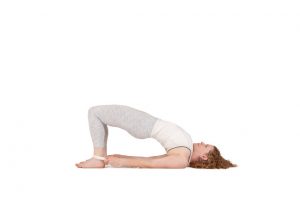 Lie on your back with your knees bent and the soles of your feet resting on the floor near your sitting bones. Lengthen your arms alongside your torso and turn your palms up. Bend your elbows to 90 degrees and press the elbows and upper arms into the floor, arching your ribcage up off the floor. Press the soles of your feet into the floor and lift your hips up.
Lie on your back with your knees bent and the soles of your feet resting on the floor near your sitting bones. Lengthen your arms alongside your torso and turn your palms up. Bend your elbows to 90 degrees and press the elbows and upper arms into the floor, arching your ribcage up off the floor. Press the soles of your feet into the floor and lift your hips up.- Straighten your arms out alongside your body. Clasp your hands underneath you or hold a yoga belt around the front your ankles, as in the photo. Rock from side to side on your shoulders until you come to rest on the tops of your shoulders.
- Press down with your feet and your arms and raise your hips up higher, lifting your buttocks until the thighs are about parallel to the floor. Keep your knees directly over the heels, but extend them forward, away from the hips. Lengthen the tailbone toward the backs of the knees.
- Roll your shoulders underneath you again, and lift your sternum toward your chin. Keep the back of your neck long and the front of your throat soft. Be aware of how the weight is distributed across your feet, making sure that the weight is equal on these four points: inside and outside balls of your feet, and insides and outsides of your heels.
- To come out, release the clasp of your hands or the belt and lower your spine slowly to the floor, one vertebra at a time.
To learn more detail about this and to fall in love with arm balances, don’t miss her workshop at Expo Yoga 2019.
Barrie Risman, E-RYT 500, YACEP, is widely regarded as one of Canada’s most highly skilled yoga educators and teacher–trainers. Her events weave together the technical precision of refined alignment-based practice with an ever-present awareness of the great wisdom of yoga philosophy distilled from decades of intensive study and practice. Barrie is the proud creator of The Skillful Yogi, a thriving online community of teachers and students dedicated to deepening their practice and living their yoga, and the author of the forthcoming book, Evolving Your Yoga: Ten Principles for Enlightened Practice. www.barrierisman.com
